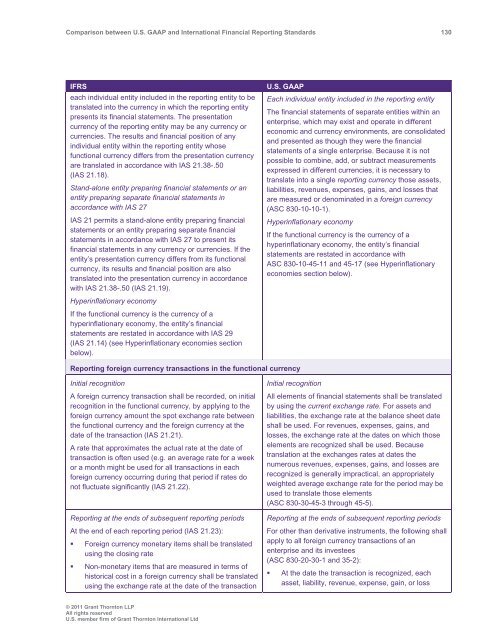Comparison between U.S. GAAP and International ... - Grant Thornton
Comparison between U.S. GAAP and International ... - Grant Thornton
Comparison between U.S. GAAP and International ... - Grant Thornton
Create successful ePaper yourself
Turn your PDF publications into a flip-book with our unique Google optimized e-Paper software.
<strong>Comparison</strong> <strong>between</strong> U.S. <strong>GAAP</strong> <strong>and</strong> <strong>International</strong> Financial Reporting St<strong>and</strong>ards 130<br />
IFRS<br />
each individual entity included in the reporting entity to be<br />
translated into the currency in which the reporting entity<br />
presents its financial statements. The presentation<br />
currency of the reporting entity may be any currency or<br />
currencies. The results <strong>and</strong> financial position of any<br />
individual entity within the reporting entity whose<br />
functional currency differs from the presentation currency<br />
are translated in accordance with IAS 21.38-.50<br />
(IAS 21.18).<br />
St<strong>and</strong>-alone entity preparing financial statements or an<br />
entity preparing separate financial statements in<br />
accordance with IAS 27<br />
IAS 21 permits a st<strong>and</strong>-alone entity preparing financial<br />
statements or an entity preparing separate financial<br />
statements in accordance with IAS 27 to present its<br />
financial statements in any currency or currencies. If the<br />
entity’s presentation currency differs from its functional<br />
currency, its results <strong>and</strong> financial position are also<br />
translated into the presentation currency in accordance<br />
with IAS 21.38-.50 (IAS 21.19).<br />
Hyperinflationary economy<br />
If the functional currency is the currency of a<br />
hyperinflationary economy, the entity’s financial<br />
statements are restated in accordance with IAS 29<br />
(IAS 21.14) (see Hyperinflationary economies section<br />
below).<br />
U.S. <strong>GAAP</strong><br />
Each individual entity included in the reporting entity<br />
The financial statements of separate entities within an<br />
enterprise, which may exist <strong>and</strong> operate in different<br />
economic <strong>and</strong> currency environments, are consolidated<br />
<strong>and</strong> presented as though they were the financial<br />
statements of a single enterprise. Because it is not<br />
possible to combine, add, or subtract measurements<br />
expressed in different currencies, it is necessary to<br />
translate into a single reporting currency those assets,<br />
liabilities, revenues, expenses, gains, <strong>and</strong> losses that<br />
are measured or denominated in a foreign currency<br />
(ASC 830-10-10-1).<br />
Hyperinflationary economy<br />
If the functional currency is the currency of a<br />
hyperinflationary economy, the entity’s financial<br />
statements are restated in accordance with<br />
ASC 830-10-45-11 <strong>and</strong> 45-17 (see Hyperinflationary<br />
economies section below).<br />
Reporting foreign currency transactions in the functional currency<br />
Initial recognition<br />
A foreign currency transaction shall be recorded, on initial<br />
recognition in the functional currency, by applying to the<br />
foreign currency amount the spot exchange rate <strong>between</strong><br />
the functional currency <strong>and</strong> the foreign currency at the<br />
date of the transaction (IAS 21.21).<br />
A rate that approximates the actual rate at the date of<br />
transaction is often used (e.g. an average rate for a week<br />
or a month might be used for all transactions in each<br />
foreign currency occurring during that period if rates do<br />
not fluctuate significantly (IAS 21.22).<br />
Reporting at the ends of subsequent reporting periods<br />
At the end of each reporting period (IAS 21.23):<br />
• Foreign currency monetary items shall be translated<br />
using the closing rate<br />
• Non-monetary items that are measured in terms of<br />
historical cost in a foreign currency shall be translated<br />
using the exchange rate at the date of the transaction<br />
Initial recognition<br />
All elements of financial statements shall be translated<br />
by using the current exchange rate. For assets <strong>and</strong><br />
liabilities, the exchange rate at the balance sheet date<br />
shall be used. For revenues, expenses, gains, <strong>and</strong><br />
losses, the exchange rate at the dates on which those<br />
elements are recognized shall be used. Because<br />
translation at the exchanges rates at dates the<br />
numerous revenues, expenses, gains, <strong>and</strong> losses are<br />
recognized is generally impractical, an appropriately<br />
weighted average exchange rate for the period may be<br />
used to translate those elements<br />
(ASC 830-30-45-3 through 45-5).<br />
Reporting at the ends of subsequent reporting periods<br />
For other than derivative instruments, the following shall<br />
apply to all foreign currency transactions of an<br />
enterprise <strong>and</strong> its investees<br />
(ASC 830-20-30-1 <strong>and</strong> 35-2):<br />
• At the date the transaction is recognized, each<br />
asset, liability, revenue, expense, gain, or loss<br />
© 2011 <strong>Grant</strong> <strong>Thornton</strong> LLP<br />
All rights reserved<br />
U.S. member firm of <strong>Grant</strong> <strong>Thornton</strong> <strong>International</strong> Ltd
















